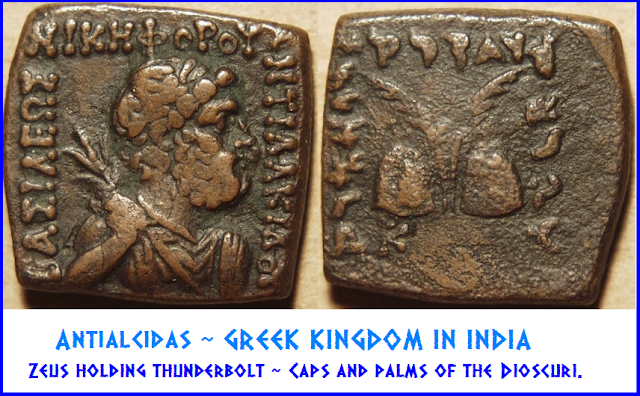Antialcidas Nikephoros (Greek: Αντιαλκίδας ο Νικηφόρος; "the Victorious", Brahmi: 𑀅𑀁𑀢𑀮𑀺𑀓𑀺𑀢𑀲 Aṃtalikitasa, in the Heliodorus Pillar) was an Indo-Greek king of the Indo-Greek Kingdom, who reigned from his capital at Taxila. Bopearachchi has suggested that he ruled in the western parts of the Indo-Greek realms, and also in eastern Punjab.
Antialcidas may have been a relative of the Bactrian king Heliocles I, but ruled after the fall of the Bactrian kingdom. Several later kings may have been related to Antialcidas: Heliokles II, Amyntas, Diomedes and Hermaeus all struck coins with similar features.
Antialcidas may have been a relative of the Bactrian king Heliocles I, but ruled after the fall of the Bactrian kingdom. Several later kings may have been related to Antialcidas: Heliokles II, Amyntas, Diomedes and Hermaeus all struck coins with similar features.
Antialcidas is known from an inscription left on a pillar (the Heliodorus pillar), which was erected by his ambassador Heliodorus at the court of the Shunga king Bhagabhadra at Vidisha, near Sanchi.
A part of the inscription says:
"This Garuda-standard was made by order of the Bhagavata ... Heliodoros, the son of Dion, a man of Taxila, a Greek ambassador from King Antialkidas, to King Bhagabhadra, the son of the Princess from Benares, the saviour, while prospering in the 14th year of his reign."
Antialcidas issued at least four different types of Attic weight tetradrachms which carried only Greek legends. These included two with the helmeted bust, as on this coin, but with two different legend arrangements, and one each with a bare-headed bust and a bust with the king wearing a kausia.He also issued at least two different monolingual drachms, a helmeted type and a kausia type. Thus, his Attic coinage was the most extensive of all the Greek kings who ruled south of the Hindu Kush. Τhis was because he acquired territory in Bactria, north of the Hindu Kush.
Sources : coinindia, Wikipedia















No comments:
Post a Comment